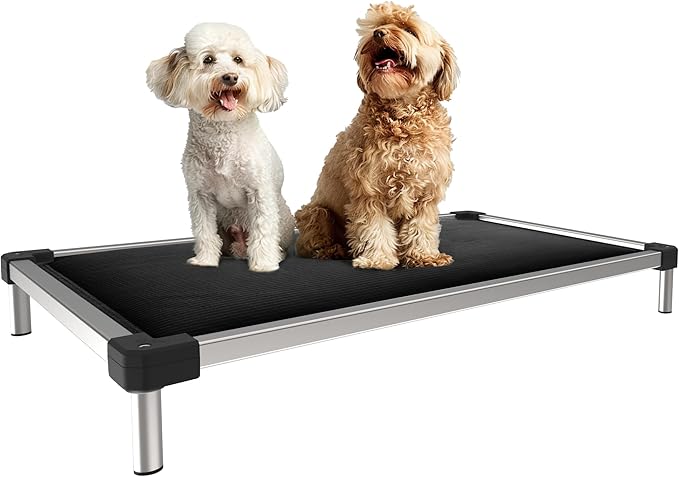What type of dog bed is best? Choosing the perfect dog bed is vital to your pet’s comfort, health and overall wellbeing. It affects slumber quality, joint support and behavior. Understanding your dog's specific needs such as size, age, sleeping habits and any ongoing health issues helps you select a bed that provides maximum comfort and support. This will ensure they have a separate comfortable place dedicated to reenergizing rest.
Factors to Consider When Choosing a Dog Bed
Several important factors should guide you in choosing a dog bed. To begin with, consider the size and weight of your dog so that it has enough room and support provided. Consider their sleeping habits which include whether they often curl up or stretch out when selecting the right shape of bed to buy them. If one of your dogs is an older one suffering from orthopaedic problems then this is something that must be taken into account as regards its age as well as health conditions. Pick materials that can withstand wear and tear plus go for beds that are easy to clean – these ones have removable washable covers thus making it much easier for you to maintain hygiene within the home. As a result of these, your dog will have a good bed providing him with peaceful sleep during night benefiting overall well-being.
Dog Beds for Small Breeds
When buying beds for small breed dogs; it is important to know what type of support and comfort they need specifically. For Chihuahuas, they need warm snug beds with high sides or bolsters around them so that they can feel safe all night long. Pomeranians, having thick fur, require ventilated plush beds that can be raised to allow for the movement of air. To take care of their strong and robust demeanour, French bulldogs need orthopedic support; as a result, they are perfect for relieving joint pressure and assuring peaceful rest. Therefore, selecting appropriate beddings designed to suit these tiny breeds guarantees that they remain at ease, well-supported and contented.

Dog Beds for Medium Breeds
It is important to think about the specific comfort of medium dog breeds when choosing dog beds for them. Such dogs need a combination of softness and firmness in regard to their bedding. Accordingly, memory foam in orthopedic beds would be very appropriate in ensuring that Beagles’ joints are not troubled with unnecessary pain. Additionally, Cockers Spaniels’ dense hair requires airy raised beds while bolstering ones will give them comfort from all sides. Also, active Border Collies must have firm orthopedic options capable of outlasting rough use while still providing enough joint support, unlike other weaker beds.
Dog Beds for Large Breeds
What are the best dog beds for large dogs? When it comes to purchasing a dog bed that will accommodate its size and weight as large breeds grow; comfort and support should be given priority above others. Orthopedic beds possessing high-density memory foam would be ideal for German Shepherds with their joints being supported and pressure points eased. Waterproof, strong, and chew-resistant beds containing a considerable amount of padding are needed for Labradors to ensure they are comfortable after their active days. Plush, cushioned beds that have washable bolsters for easy maintenance and extra-neck support are what Golden Retrievers want to thrive in Choosing the right bed will enable these large breeds to rest in comfort and support.
Dog Beds for Giant Breeds
What are the best dog beds for large dogs? When choosing dog beds for giant breeds, it's crucial to focus on providing ample space and support to accommodate their massive size and weight. Great Danes require huge orthopedic beds with bulky memory foam for joint support as well as reducing pressure points. Sain Bernard needs durable spacious beds with covers that can withstand drooling and can easily be cleaned as well. Mastiffs prefer large firm supportive dog-beds made of robust construction which is capable of supporting them Selecting the right bed ensures these giant breeds have a comfortable, supportive place to rest that meets their specific needs.
Specialized Dog Beds
Specialized dog beds cater to specific needs and conditions, ensuring optimal comfort and support. Orthopedic dog beds for senior dogs contain visco-elastic foam that can relieve arthritic pain and add cushion which old bodies need. Cooling dog beds for hot climates employ air-permeable fabric along with gel-based memory foam to control the temperature fluctuations thereby avoiding overheating. Heated dog beds for cold climates have safe, low-wattage heating pads to keep them cozy in the cold season. Travelling dog beds for restless dogs are lighter than air, easily portable and simple to pack so that they can provide comfort and a sense of home when away. These diverse options make sure dogs get the right care as well as comfort.
Materials and Types of Dog Beds
What type of bed do dogs prefer?
When thinking about materials and types of dog beds, it is important to match the bed with your friend’s needs and requirements. Memory foam pet mattresses aid in providing good support as well as cushioning, great for canines having joint problems or older animals who want extra pampering.
Cotton and polyester pet mats blend softness with durability making them suitable either for daily use or easy maintenance reasons. Eco-friendly animal sleeping bags are made up of materials that will not affect the environment; thus, they should be bought by individuals who are concerned about global warming issues.
Raised cooling pet mats allow air to circulate under your pets’ abdomens while being outside in hot weather conditions; hence these models are also appropriate for outdoorsy persons. The bolster and nest styles give a feeling of safety due to their raised sides which makes them ideal for those dogs who love sitting on their hind legs with their tails tucked beneath them.

Custom Dog Beds
Personalized dog beds are the best solution for individual requirements and preferences. They are also designed to satisfy personal wants such as special orthopedic support, larger dimensions for giant breeds and specific materials for dogs with allergies. These custom-made beds guarantee maximum convenience and use. Conversely, homemade dog bed ideas present an imaginative way to go about it: pet owners could utilize old blankets, pillows or foam to create a bed. This method saves money while affording one the pride of having made a private space for his pet. Custom-made dog beds ensure that all dogs have what they need.
Training Your Dog to Use Their New Bed
Training your dog to get used to their new bed requires some steps in order for them to feel comfortable and secure in it. The first thing you should do is place the bed in a quiet familiar place where your dog usually rests. You can put treats or toys on the bed so that they can explore and lie on it and give praise once they investigate or lay down on it. This will enable your canine to associate good memories with this location using positive reinforcement such as treats and verbal cues like "bed". Forcing her onto her new sleep surface should not be done if she hesitates; instead, use incentives along with guidance to make her get there softly. This can be done by gradually increasing exposure to the bed and providing reassurance. Your dog will come to know their new bed as a source of relaxation and comfort, which will make it their favorite resting place. In summary, it is important to take into account the specific features and preferences of your pet in order to buy an ideal dog bed for them.
Summary
The first thing you should do is make sure that it has enough space that allow your pet to move freely when sleeping. The shape and design of the bed should depend on how your pets sleep while considering whether they lie down or stretch out in bed. Also among young active dogs resilient materials able to withstand strong plays are required whereas in old dogs with health problems, orthopedic beds are necessary since this provides the joint support needed. Additionally, factors like ease of cleaning and maintenance are essential to keep the bed fresh and hygienic. Ultimately, Investing in a good quality bedding material for your pup enhances its comfort while supporting its general well-being (and happiness).
Buy playpens for your fur buddy, you can check out more on our store
FAQ
How often should I replace my dog's bed?
You should buy a new one if there are signs of wear such as compressed padding, bulging or fabric rips on your dog’s bed. Most often this happens every 1-2 years but depending on the size of your dog, how active he/she is and how good a mattress can vary.
What is the best way to clean a dog bed?
How to clean a dog’s bed depends on whether or not it is removable. For those with covers that can be removed, machine-wash them with pet-friendly soap powders in the gentle cycle and air dry or dry low. Alternatively, one may choose to tumble-dry them under low setting. When there are no removable covers on your beds, you should start by vacuuming to remove hair and debris then spot clean using a pet-safe cleaner and a damp cloth. Ensure the bed is completely air-dried before laying new bedding on top of it for hygiene and comfort purposes.
Can my dog have multiple beds?
Yes, your dog can have multiple beds; this way they will find different places in your house where they can rest or sleep. This means more comfortable areas for the dogs in different rooms that suit their taste depending upon the time of day. Additionally, if you have several pets at home and want everyone to have their own territory, this is good as well. However, it is essential to check if each of these beds matches its size, sleeping habits as well as its comfortable needs for better health.
What should I do if my dog doesn’t like their new bed?
If your dog does not take up his/her new bed immediately try some methods that could encourage acceptance of the item. Begin by putting the bed in a familiar place where your dog likes resting while avoiding jumping onto chairs or couches for instance. You can also associate positive reinforcement such as feeding him/her when lying down with certain words like “bedtime” whenever he/she lies on it with praise coming from family members also praising her/him so that she/he realizes that’s what she/he has done was right. Moreover placing an item containing your scent onto the blanket would make it enticing too. If you still can’t convince yourself, then start using your bed as his napping place until he gets used to it. Better yet, put some familiar stuff on top of it and see what happens. One thing that should be put in mind is that patience and positive reinforcement are the keys helping dogs get used to their new beds.
Are there any health benefits to specific types of dog beds?
However, there are some types of dog beds that are designed to provide specific health benefits. Orthopedic dog beds for instance give necessary joint support for the aged or arthritic dogs. Cooling beds enable the regulation of body temperature so that they are appropriate for dogs living in warmer areas or those with overheating tendencies. In contrast, heated beds provide warmth that may comfort dogs in colder surroundings or dogs that feel cold very easily. Additionally, an elevated bed facilitates joint relief and improved airflow which is good for dogs who need extra support or have problems associated with joint pain. The selection of an appropriate bed based on the individual health condition of your animal friend and its environment will greatly improve its well-being.


Share:
How to choose a sturdy and durable dog bed?
Why Do Dogs Dig in Their Beds?